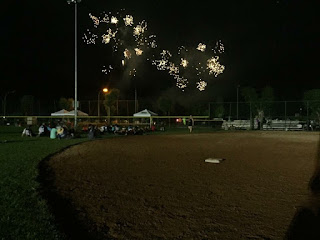A month ago, I took off to Italy for a softball tournament. Our team came in second place, Woohoo! What's especially neat is that I can casually talk about how I played softball in a dormant volcano and watched a fireworks show... from inside a volcano! Such a fun weekend! And we did some site seeing in Rome, Naples, and Capri, making sure to fill ourselves with history, pizza, pasta, and sangria!
photo credit: J.M.
Rome
When we landed in Rome, I thought it was going to be this beautiful and clean city, but it wasn't. It was kind of dirty. Not Paris dirty, but definitely not as clean as the UK. Still, the city was pretty spectacular. Rome is one of the oldest cities in Europe and is known as the birthplace of western civilization and may even be the first metropolitan area. It is sometimes referred to as Roma Aeterna "Rome Eternal". Throughout the city evidence of its history flourishes from the early Roman Mythology to the Medieval times and the Renaissance. The Roman Empire (Republic) stretched far and wide throughout history. Much of Europe and other parts of the world, at one point in time, has felt its influence.
The first evening, we walked from our super cute airbnb to the Trevi Fountain. Fontana do Trevi, as it's known in Italian, is the largest fountain in Rome and perhaps the most famous in all the world. Many people come to toss a coin into the fountain in hopes that a wish will be granted in return.
The following day, we made our way to the Colosseum. It was quite remarkable to behold, and breathtaking to think that the site has been in use for over 2,000 years! It's Latin name is Flavian Amphitheater, as it was constructed by the Flavian dynasty emperors. 50-80,000 spectators could be in attendance for any event held in the Colosseum. Some events throughout history included gladiator fights, public spectacles, markets, animal hunts, plays and re-enactments, and other religious events.
The Colosseum suffered a major fire and was left to ruins until the Medieval period when it was revived. An earthquake in 1349 caused major damage to Colosseum. A religious order moved into the Colosseum in the mid 14th century and remained through the 19th century. In 1749 Pope Benedict XIV declared the site to be holy and installed the Stations of the Cross.Today, the Colosseum is a major tourist attraction in which millions of visitors come to see.
Just a cautionary note: There are all kinds of people that will approach you trying to sell items or quick passes into major tourists sites such as the Colosseum. We had several try to sell us fast track tickets as a "group" for €30pp when we purchased our individual for €13 (and there was no line). Peddlers will also approach you while eating!
We didn't have time to see the Vatican. Will have to save that for another trip. However, we did check out the Pantheon (not to be confused with the Parthenon in Greece). The Pantheon is free to enter; however, it is an active church so remember to be quiet and if you feel inclined, give a donation.
The Pantheon was commissioned by Marcus Agrippa and completed by emperor Hadrian. The Pantheon remains an impressive piece of ancient Rome as it has been in continuous use. Originally, it was built for the gods of Roman Mythology; however in the 7th century, converted to a Christian church dedicated to Saint Mary and the Martyrs. The inside has a wide open oculus and is the world's largest unreinforced dome, Inside, what I found interesting was the various crosses around the room and stories each depicted. Renaissance painter Raphael is buried here.
Pompeii
Pompeii was a short drive from Naples, where we were staying for our softball tournament. The short amount of time we had wandering through Pompeii, seeing the ruins and even bodies, was not enough. Fascinating and eerie are the two words I would use to describe Pompeii. The oldest evidence of Pompeii's existence dates back to the late 7th century B.C. An earthquake shook the area in 62 A.D. and 17 years later on August 24, 79 A.D. Mount Vesuvius erupted, burying Pompeii under a ton of ash, about 13-20 feet. The city lay buried and quiet for 1500 years when in 1599, the city was uncovered. Another 150 years later, in 1749, major excavations were done revealing more of it's history and has continued since. Pompeii is now a UNESCO World Heritage site.
Capri
After a softball tournament, the best thing to do is relax. And what better way than to relaxing touring the island of Capri in a boat! We went around the island, stopping for swim breaks and scenic views. It was fantastic to get to go swimming! In England, the weather is definitely too cool for that, although some people still do. However, Italy was around 90 all week. The water was pretty salty, but such a beautiful blue! We even went inside the Blue Grotta (Grotta Assurra in Italian) cave. There were many scenic views from the lighthouse to the Heart of the Sea.
After Capri, it was back to England for even MORE VACATION! Read my trip blogs on Bath and Hay-on-Wye coming soon!































Very well written! The descriptions make me want to experience it myself !
ReplyDelete